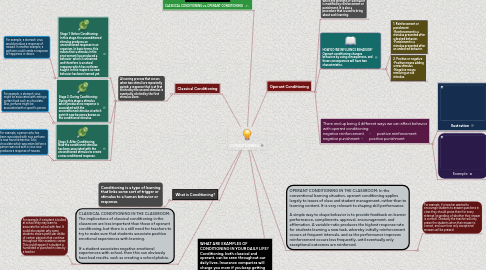
1. WHAT ARE EXAMPLES OF CONDITIONING IN YOUR DAILY LIFE? Conditioning, both classical and operant, can be seen throughout our daily lives. Insurance companies will charge you more if you keep getting into accidents (negative punishment) or give you congratulatory certificates for safer driving (positive reinforcement).
2. What is Conditioning?
2.1. Conditioning is a type of learning that links some sort of trigger or stimulus to a human behavior or response.
3. Classical Conditioning
3.1. A learning process that occurs when two stimuli are repeatedly paired; a response that is at first elicited by the second stimulus is eventually elicited by the first stimulus alone.
3.1.1. Stage 1: Before Conditioning: In this stage, the unconditioned stimulus produces an unconditioned response in an organism. In basic terms, this means that a stimulus in the environment has produced a behavior which is unlearned and therefore is a natural response which has not been taught. In this respect, no new behavior has been learned yet.
3.1.1.1. For example, a stomach virus would produce a response of nausea. In another example, a perfume could create a response of happiness or desire.
3.1.2. Stage 2: During Conditioning: During this stage a stimulus which produces no response is associated with the unconditioned stimulus at which point it now becomes known as the conditioned stimulus.
3.1.2.1. For example, a stomach virus might be associated with eating a certain food such as chocolate. Also, perfume might be associated with a specific person.
3.1.3. Stage 3: After Conditioning: Now the conditioned stimulus has been associated with the unconditioned stimulus to create a new conditioned response.
3.1.3.1. For example, a person who has been associated with nice perfume is now found attractive. Also, chocolate which was eaten before a person was sick with a virus now produces a response of nausea.
4. CLASSICAL CONDITIONING IN THE CLASSROOM: The implications of classical conditioning in the classroom are less important than those of operant conditioning, but there is a still need for teachers to try to make sure that students associate positive emotional experiences with learning. If a student associates negative emotional experiences with school, then this can obviously have bad results, such as creating a school phobia.
4.1. For example, if a student is bullied at school they may learn to associate the school with fear. It could also explain why some students show a particular dislike of certain subjects that continue throughout their academic career. This could happen if a student is humiliated or punished in class by a teacher.
5. CLASSICAL CONDITIONING vs. OPERANT CONDITIONING
6. OPERANT CONDITIONING IN THE CLASSROOM: In the conventional learning situation, operant conditioning applies largely to issues of class and student management, rather than to learning content. It is very relevant to shaping skill performance. A simple way to shape behavior is to provide feedback on learner performance, compliments, approval, encouragement, and affirmation. A variable-ratio produces the highest response rate for students learning a new task, whereby initially reinforcement occurs at frequent intervals, and as the performance improves reinforcement occurs less frequently, until eventually only exceptional outcomes are reinforced.
6.1. For example, if a teacher wanted to encourage students to answer questions in class they should praise them for every attempt (regardless of whether their answer is correct). Gradually the teacher will only praise the students when their answer is correct, and over time only exceptional answers will be praised.
7. Operant Conditioning
7.1. Is a learning process through which the strength of a behavior is modified by reinforcement or punishment. It is also a procedure that is used to bring about such learning.
7.2. HOW DO WE INFLUENCE BEHAVIOR? Operant conditioning changes behaviors by using consequences, and these consequences will have two characteristics.
7.2.1. 1. Reinforcement or punishment -Reinforcement is a stimulus presented after a desired behavior. -Punishment is a stimulus presented after an undesired behavior.
7.2.2. 2. Positive or negative -Positive means adding a new stimulus. -Negative means removing an old stimulus.
7.3. There end up being 4 different ways we can affect behavior with operant conditioning: negative reinforcement - positive reinforcement negative punishment - positive punishment
7.3.1. Ilustration
7.3.2. Example

